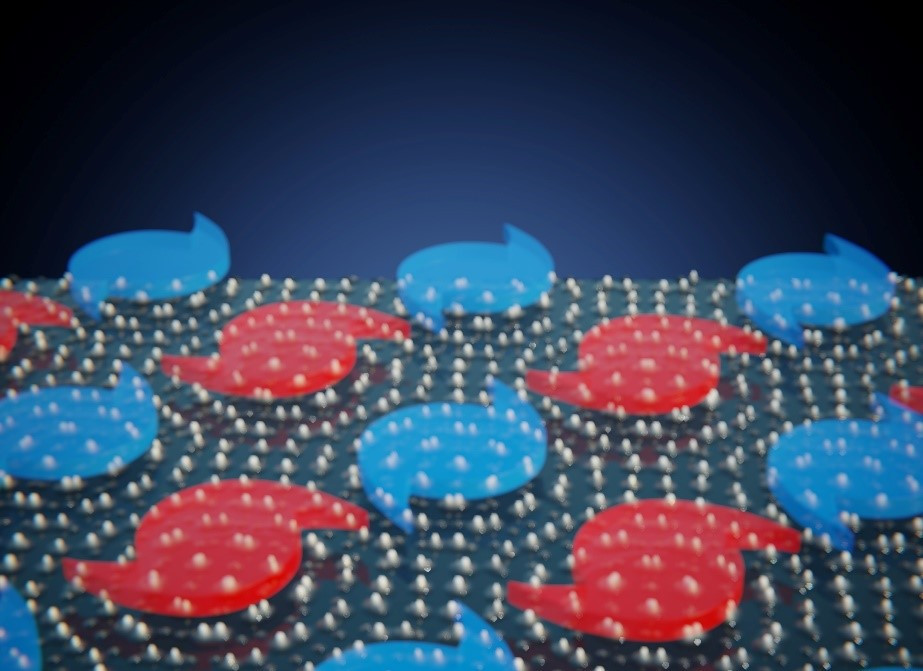The manufacture of twisted oxide crystals opens new possibilities in information storage

The Institute of Materials Science of Madrid (ICMM-CSIC) is participating in an international research effort that has successfully assembled single-crystal layers of ceramic oxides just a few atoms thick, rotated at arbitrary angles, and bonded together to form a new artificial crystal that does not exist in nature. This discovery of a new generation of artificial materials opens up new avenues for increasing the storage capacity and energy efficiency of future computing devices.
The work, published in Nature and carried out within the Associated Unit UCM/CSIC 'Laboratory of Heterostructures with Spintronics Applications', demonstrates that at the interface between rotated ferroelectric layers of barium titanate (BaTiO3), "emergent properties appear that could revolutionize the science and technology of materials," explains Mar García, a researcher at ICMM-CSIC.
"In nature, crystals spontaneously grow with well-defined facets because they maintain the orientation of the so-called crystallographic axes," mentions Jacobo Santamaría, a professor at the Complutense University of Madrid (UCM) and lead author of the study. So far, material growth technologies have exploited this natural tendency by combining very thin layers of different materials, stacking them on top of each other while maintaining the crystalline orientation and arrangement of atoms in the different layers. "The result is the emergence of new and interesting properties at the interfaces or junction surfaces between the crystalline layers, which have allowed, for example, the construction of electronic devices and their use in information and communication technologies," adds the researcher.
Now, this work has fabricated oxide crystals with a degree of freedom that does not exist in nature and has never been achieved before: controlled rotation between atomic-thickness crystalline layers, a technique called 'twistronics'. The bond between these layers gives rise to a characteristic structural and interaction pattern (moire pattern) that is the origin of the emergent properties found.
"The work demonstrates that the rotation between layers induces a ferroelectric state never before observed, in which electric polarization vortices (whirlpools) alternate with a minimal lateral size (a few atoms), and could serve as the information elements (bits) of future memories," details García. "We have created these vortices, a nanoscale pattern of an entity that is very robust," continues the scientist, noting that if electric fields are applied, "different states can be created that can store information on the nanoscale."
This state would allow for storage densities exceeding 100 terabytes per square inch (Tbits/in2), thus surpassing the current limit of 1Tb/in2 at which the information density of computer memories has stagnated. "This would address the technological challenge and energy sustainability of a global information storage that could surpass yottabytes (1024 bytes) in the present decade," argues Santamaría.
Bibliographic reference: G. Sánchez-Santolino, V. Rouco, S. Puebla, H. Aramberri, V. Zamora, M. Cabero, F. A. Cuellar, C. Munuera, F. Mompean, M. Garcia-Hernandez, A. Castellanos- Gomez, J. Íñiguez, C. Leon, J. Santamaria. A 2D ferroelectric vortex pattern in twisted BaTiO3 freestanding layers. Nature. DOI: 10.1038/s41586-023-06978-6
Instituto de Ciencia de Materiales de Madrid (ICMM)
Sor Juana Ines de la Cruz, 3
Cantoblanco, 28049
Madrid, España
Telephone: (+34) 91 334 90 00
Email: @email
Communication Office: @email

Acknowledge the Severo Ochoa Centres of Excellence program through Grant CEX2024-001445-S/ financiado por MICIU/AEI / 10.13039/501100011033

Contacto | Accesibilidad | Aviso legal | Política de Cookies | Protección de datos